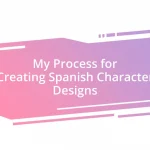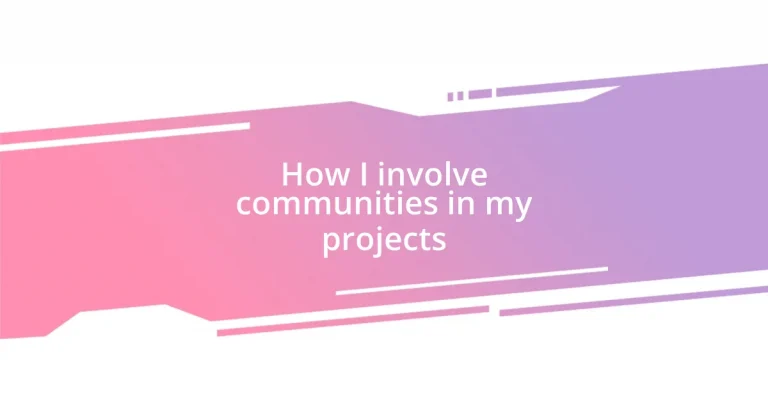Key takeaways:
- Active community engagement thrives on genuine relationships, listening to residents, and fostering open dialogues to understand their needs.
- Collaboration with local leaders and community members enhances project ownership, encourages innovative solutions, and strengthens trust within the community.
- Implementing feedback mechanisms and evaluating outcomes helps gather valuable insights, ensuring projects align with community aspirations and enhance future initiatives.

Understanding community engagement
Community engagement means more than just getting people involved; it’s about building genuine relationships and trust. I remember a project where I initially struggled to connect with locals. It was only when I started attending community events that I began to understand their needs and cultural nuances. Have you ever found yourself in a similar situation, where diving deeper into community life brought unexpected insights?
Creating a space for open dialogue is essential. I once organized a workshop where residents shared their stories and ideas. Listening to their experiences not only inspired our project’s direction but also forged a bond that elevated our work. It made me realize how much richer our projects become when we actively listen. Doesn’t it feel powerful when voices are heard and valued?
Collaboration stands at the heart of community engagement. I’ve often found that when community members feel ownership over the process, magic happens. Once, a group of youth in my project proposed a radical shift in our strategy. Their enthusiasm and fresh perspective ultimately led to unexpected success. Isn’t it remarkable how empowering others can lead to innovative solutions that might never have surfaced otherwise?

Identifying community needs
Identifying community needs begins with a genuine connection. I recall a time visiting a neighborhood that had been overlooked for years. Instead of rushing in with solutions, I spent my first few visits simply walking the streets, chatting with residents, and absorbing their experiences. It was enlightening to hear firsthand about the challenges they faced, which shaped my understanding of what they truly needed.
Using surveys and community meetings can help gather vital data, but I believe face-to-face conversations are irreplaceable. During one project, I set up informal listening sessions at local cafes. To my surprise, residents opened up about their aspirations and concerns in a relaxed setting, sharing thoughts I had never anticipated. These interactions highlighted the importance of creating spaces where people feel safe to express their needs.
Moreover, conducting assessments through local partnerships can uncover hidden challenges. Teaming up with a local school allowed me to tap into the youth’s perspective. They revealed educational gaps that hadn’t been on my radar. I’ve learned that involving various community stakeholders leads to a fuller picture of needs, ensuring that my projects are aligned with what people actually want and need.
| Method | Benefits |
|---|---|
| Walking and Engagement | Builds trust and provides firsthand insights |
| Surveys | Gathers quantifiable data |
| Listening Sessions | Encourages open dialogue and reveals deeper issues |
| Partnerships | Brings diverse perspectives to light |

Building trust within the community
Building trust within the community is a journey that takes patience and genuine intent. I remember a neighborhood project where my initial outreach didn’t go as planned. I approached it with a checklist mentality, thinking I could just tick off tasks, but this left residents feeling skeptical. It wasn’t until I made an effort to show vulnerability—sharing my own story and struggles—that I saw walls come down. In those moments, I understood that trust is built not just through what we say, but through authenticity and shared experiences.
Here are some strategies I’ve found effective in nurturing trust:
- Be Present: I learned that simply being there, whether at community events or just chatting with residents, proves that you care.
- Share Your Journey: I’ve shared my own challenges openly during discussions; it helps people see me as a part of their community rather than an outsider.
- Follow Through: If I promise to help with an initiative, I make it a priority. Consistent follow-through demonstrates reliability.
- Celebrate Together: When a local initiative succeeds, celebrating those wins strengthens our bond and creates a sense of shared pride.
Trust isn’t built overnight; it’s cultivated over time through meaningful interactions and shared commitments.

Collaborating with local leaders
Collaborating with local leaders has been one of the most rewarding aspects of my projects. I vividly remember attending a town hall meeting where a local leader stood up, passionately advocating for their community. Their voice was filled with conviction, and it struck me how impactful collaboration can be when leaders serve as a bridge between the community and project initiatives. I quickly realized that involving these local figures fosters trust and facilitates smoother communication.
In my experience, local leaders often have a deep understanding of their community’s dynamics. During another project, I partnered with a respected neighborhood figure who knew the ins and outs of what residents cared about most. Their insights were invaluable—I learned about historical grievances that still resonated today. It made me question: how much can we leverage these relationships to enhance our understanding of the community? The answer has always been clear to me: a lot.
Engagement doesn’t stop at just attending meetings, though. I’ve found that working alongside local leaders in hands-on activities, like community clean-ups, creates a strong sense of shared purpose. The camaraderie that blossoms during these events is palpable. Suddenly, we aren’t just individuals working on a project; we become a united front, focused on making a genuine difference. This synergy often inspires more residents to join in, further expanding our reach and impact.

Involving community members in planning
Involving community members in the planning process is essential for fostering ownership and commitment to any project. I remember a project brainstorming session where I invited local residents to share their visions. This open dialogue not only generated innovative ideas, but it empowered individuals to invest in the plan because they felt their perspectives mattered. Have you ever noticed how exciting it is when people light up sharing their ideas? That energy can transform a project.
My approach often includes creating smaller focus groups tailored to specific interests within the community. For instance, I once organized a workshop for parents concerning youth programs. The passionate discussions that unfolded were incredible! Parents shared not only their expectations but also their fears and hopes for their children’s future. It struck me then—how essential it is to provide spaces for these candid conversations. When planning is inclusive, the outcomes reflect the true needs of the community.
I also find that utilizing accessible language and visual aids can make planning sessions more inviting. In one project, I used simple graphics to illustrate complex ideas, and I noticed that even the quietest group members began participating. The shift was profound; when everyone understands the planning aspects, they’re more likely to voice their thoughts. Isn’t it empowering to see the community come alive with ideas that truly reflect their shared goals? This collective input creates a well-rounded plan that resonates with everyone involved.

Implementing feedback mechanisms
Implementing feedback mechanisms is crucial for ensuring that community voices are heard and valued throughout the project. I recall setting up a simple online survey after a community event, eager to collect thoughts and opinions. The comments poured in, overflowing with enthusiasm and constructive criticism. It reassured me that when people know their feedback is genuinely sought after, they engage more deeply in the process.
During another project, I instituted a regular feedback loop using a combination of in-person meetings and digital platforms to keep everyone in the know. After each phase of the project, I invited community members to share their reflections. It was incredible how these conversations revealed hidden concerns and ideas I hadn’t considered.Receiving this real-time feedback was an eye-opener; it made me realize that the more accessible we make our feedback channels, the richer the insights we gather.
I’ve also experimented with informal feedback sessions, like coffee chats in local cafes. Those laid-back environments often encourage more candid conversations. I remember a participant sharing how a recent decision impacted their daily life, which opened up a dialogue I hadn’t anticipated. Isn’t it amazing how sometimes the most significant insights come from unexpected places? Those moments remind me of the genuine connection we can foster through continuous feedback—a key element to enriching our projects.

Evaluating community involvement outcomes
Evaluating community involvement outcomes is where the magic really happens. I often reflect on past projects and assess how well we achieved our goals together. For instance, after one community initiative, I realized we had not just met our objectives but exceeded them by embracing input from all participants. Isn’t it fascinating how measuring outcomes can reveal both successes and potential areas for improvement?
Sometimes, I like to use tools like surveys or interviews after the project wraps up. In one case, we gathered data through informal chats with community members over lunch. Their candid feedback helped illuminate just how deeply the project had affected their lives. It’s moments like these that remind me: when we take time to evaluate, we gain valuable insights that can shape future projects. How do you gather feedback after a project? I find that such evaluations are not just about numbers; they reveal the stories and experiences that statistics alone cannot capture.
I also pay close attention to the emotional responses of community members. In a recent project, I observed genuine excitement and pride when participants shared how they felt involved in shaping their neighborhood. Seeing their faces light up was a powerful reminder of the human aspect behind every initiative. Evaluating these emotional outcomes not only helps me improve future endeavors but also strengthens the bond between the community and the project team, don’t you think?














